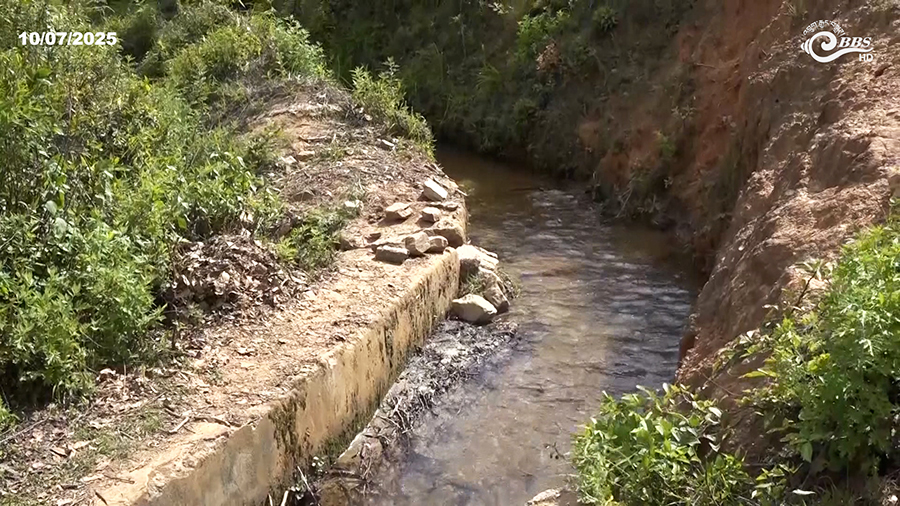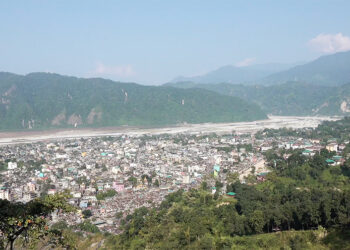 In Wangdue Phodrang’s Gase Tshogom Gewog, residents continue to grapple with a persistent shortage of irrigation water. Locals say the ongoing issue has severely impacted their agricultural activities and livelihoods. However, a major irrigation project planned to be carried out within the next five years is giving hope to farmers.
In Wangdue Phodrang’s Gase Tshogom Gewog, residents continue to grapple with a persistent shortage of irrigation water. Locals say the ongoing issue has severely impacted their agricultural activities and livelihoods. However, a major irrigation project planned to be carried out within the next five years is giving hope to farmers.
 Amidst irrigation water shortage, farmers continue to carry out paddy plantation work. They say sometimes rainfall helps provide some water for the paddy plantation, but it is unreliable, as the water quickly dries up during sunny days.
Amidst irrigation water shortage, farmers continue to carry out paddy plantation work. They say sometimes rainfall helps provide some water for the paddy plantation, but it is unreliable, as the water quickly dries up during sunny days.
 Farmers say their irrigation water supply from the existing source mostly depends on rainfall. They say the existing irrigation source is insufficient for their agricultural work unless it is supplemented by rain. Paddy saplings can be seen drying up due to an inadequate water supply.
Farmers say their irrigation water supply from the existing source mostly depends on rainfall. They say the existing irrigation source is insufficient for their agricultural work unless it is supplemented by rain. Paddy saplings can be seen drying up due to an inadequate water supply.
This problem is not new for the gewog. People have been waiting for decades to receive a reliable and sufficient irrigation water supply.
Due to the shortage, locals say, most of their farm land has remained fallow. They fear that the situation might worsen if immediate intervention is not taken. Estimates show that almost 280 acres of wetland and 80 acres of dry land are left fallow in the gewog today.
 According to the people, an insufficient water supply also affects the yield, and when there is no good harvest, people gradually become demoralised and lose interest in farming.
According to the people, an insufficient water supply also affects the yield, and when there is no good harvest, people gradually become demoralised and lose interest in farming.
Khatoedkha Tshogpa Karma said, “Back in the time of our forefathers, I did not see even a single piece of land left uncultivated. All the paddy fields were used for rice cultivation. In winter, people also grew crops like wheat and mustard. However, with rising temperatures and the impacts of climate change, we are now facing severe irrigation water shortages. These days, forget about growing winter crops, it’s even difficult to cultivate paddy in the summer, forcing many to leave their land fallow.”
Gase Tshogom Mangmi Kinley Wangchuk also said, “Firstly, there is the challenge of untimely rainfall. Secondly, disputes often arise over the distribution of water. Even though our people work with dedication and high hopes, agricultural production falls short of expectations due to the lack of adequate water. Ultimately, this has a direct impact on people’s livelihoods.”
“In my chiwog, we had enough land. However, due to inadequate irrigation water, many fields remain fallow. As a result, some households struggle to produce enough food even for a year. Growing vegetables during winter is also difficult. So, around 20 per cent of the population in the chiwog is severely affected. With the current level of production, it will be difficult to sustain livelihoods in the coming year,” said Kinley Dendup, Changkha Tshogpa, Gase Tshogom Gewog.
However, the problem is likely to be resolved by 2030, as there is a plan to construct an integrated water supply system from Hetsho Tsangchhu, located over 20 kilometres from the existing source.
Gase Tshogom Gup Chado said, “The Asian Development Bank will fund the project, with the total estimated cost exceeding Nu 600 M. All survey work has been completed, and the project has now entered the tendering phase. The tender is expected to be floated either by the end of this month or early next month.”
 The project is expected to provide sufficient drinking and irrigation water for both Gase Tshogom and Gase Tshowom gewogs, improving water access and transforming local livelihoods.
The project is expected to provide sufficient drinking and irrigation water for both Gase Tshogom and Gase Tshowom gewogs, improving water access and transforming local livelihoods.
Changa Dorji, Wangdue Phodrang
Edited by Kipchu








